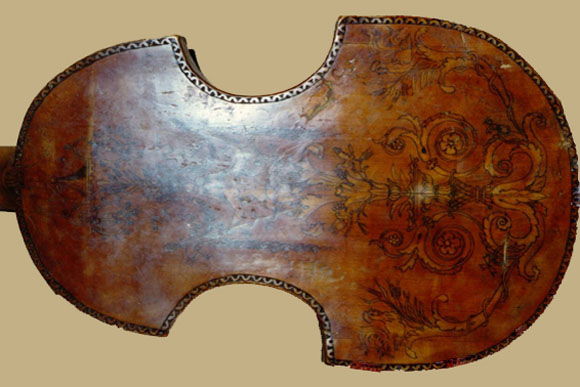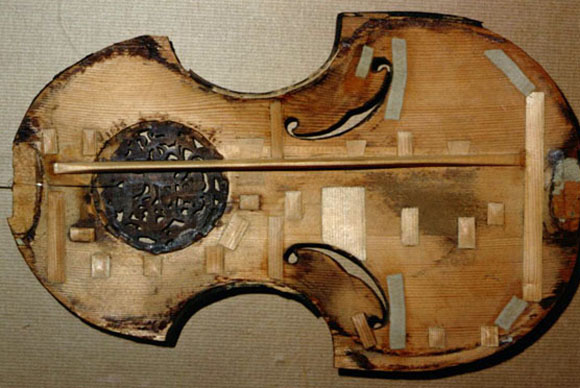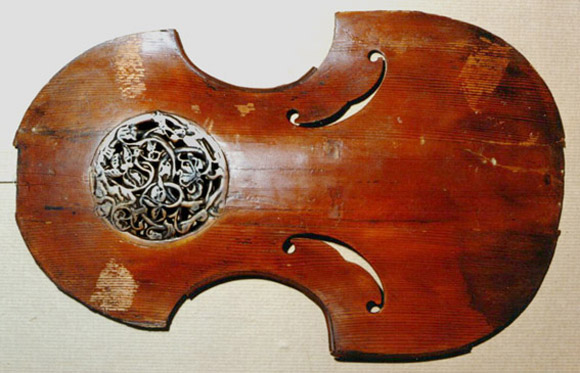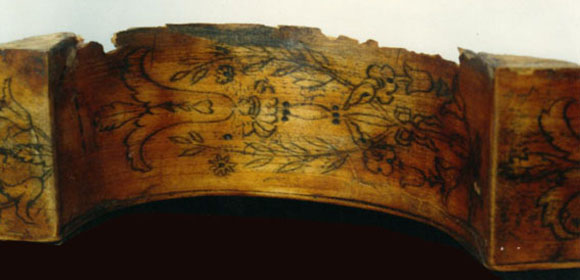|
This instrument (C 39) kept in the Instrumental Museum in Nice, is representative of a fashion common around the end of the 19th century for “antique” and “pastiche”.
In 1994, when the Museum consigned us the instrument to be restored, it was in very poor conditions. The restoration strategy was therefore to simply put the instrument together in view of its eventual exhibition. The difficulties were:
- the fragility of the instrument, caused by the numerous worm galleries,
- wood missing on the ribs,
- problems due to glueing back together the top to the back,
- varnish restoration prior to the setting up of strings and accessories.
The instrument having laid open in two parts for years, the rib and table borders were very damaged, wood was missing in several areas and/or suffered deformations.
A scotch tape holding the top to the ribs left a sign and removed part of the original varnish.

Our working schedule was as follows :
The bass bar was glued again
The back support was glued back to the bottom of the instrument, after being cleaned
The worm galleries were cleaned, tapped and sometimes doubled
The apocryph parts were removed or cut new
The top was moulded to regain its balance and allow for glueing
Eventual wood chips were glued in place
Cracks were cleaned and glued
A corner, missing in part, was made (in copy), as well as some of the linings
A new (partial) purfling in walnut was inserted
A new nut was made for the bottom
A new peg was done (in copy)
A new button was made
Glueing of the whole instrument
General cleaning, small taps
Varnish & patina touch up
A new bridge was made
Set up : strings & accessories





This cosmetic restoration did not create too many problems. The interest of this work regards mostly expertise. Under the patronym of Gagliano, we find members of an important family of violin makers working in Naples during the 18 & 19th centuries, constructing a large number of quality instruments. The study of this instrument, made easier since it was in two parts so that the inside construction was accessible, and the comparison with the works of other contemporary violin makers from Naples, allowed us to establish that the construction had nothing in common with the violin making taking place in Naples around the end of the 18th century: the varnish and the interior construction were rather those used at the end of the 19th century.
In that period, collecting musical instruments was a very fashionable activity amongst rich “connoisseurs” of the good society. Some dealers offered “fantasy” instruments, inspired from “Ancient Times”, richly decorated, made by cabinet makers and did not correspond to violin making criteria but to aesthetic choices: number of strings, inlays, atypical material used, fantasy diapason (pitch), design of “f” holes, location of the roses, etc. These instruments were often baptized with prestigious names to valorize collections. Leopoldo Franciolini (1844-1920), dealer of antiques in Florence, was probably the most well known, but he was not the only one to offer to a rich clientele musical objects intended for decoration -- “artistic false”-- nowadays still kept in contemporary collections under false attributions.
Nota-bene.
Since 2004, the application of the "laws regulating the Museums" has obligated the French museums to hire – for the restoration of objects kept in public collections – "habilitated" restorers. By these terms, we intend persons who have received the State diploma delivered by the Institute for the National Patrimony. This diploma covers all kinds of techniques and materials, but neither expertise of musical instruments nor lutherie or acoustics are taken in consideration on the cursus. From now on, only the "habilitated" restorer for "wood" (all the woods from all over the world?) is qualified to restore objects of the patrimony kept in our national collections and can equally treat beams or floors, furnitures or boats, statues and musical instruments as long as this person has the "habilitation". Therefore, a polemic has started between the museum curators who, realizing their incompetence in the field of lutherie wish to keep the historic instruments only for their visual and cultural aspect and the luthier who consider that the sound of an instrument, being its own specificity and identity, must be restored on the same level as the box that produces it.
Professionals who have – long before the title of "curator" was invented – analyzed, expertised, constructed and restored musical instruments (by countries and by categories: wind, stringed, keyboards, brass, etc.) find themselves put aside from the French public collections.
The "habilitation" for a non universitarian being almost impossible to obtain, these professionals have to apply their art to private collections.
Read: “Habilitation-restaurateur-des-musees.com” (in French).
|
